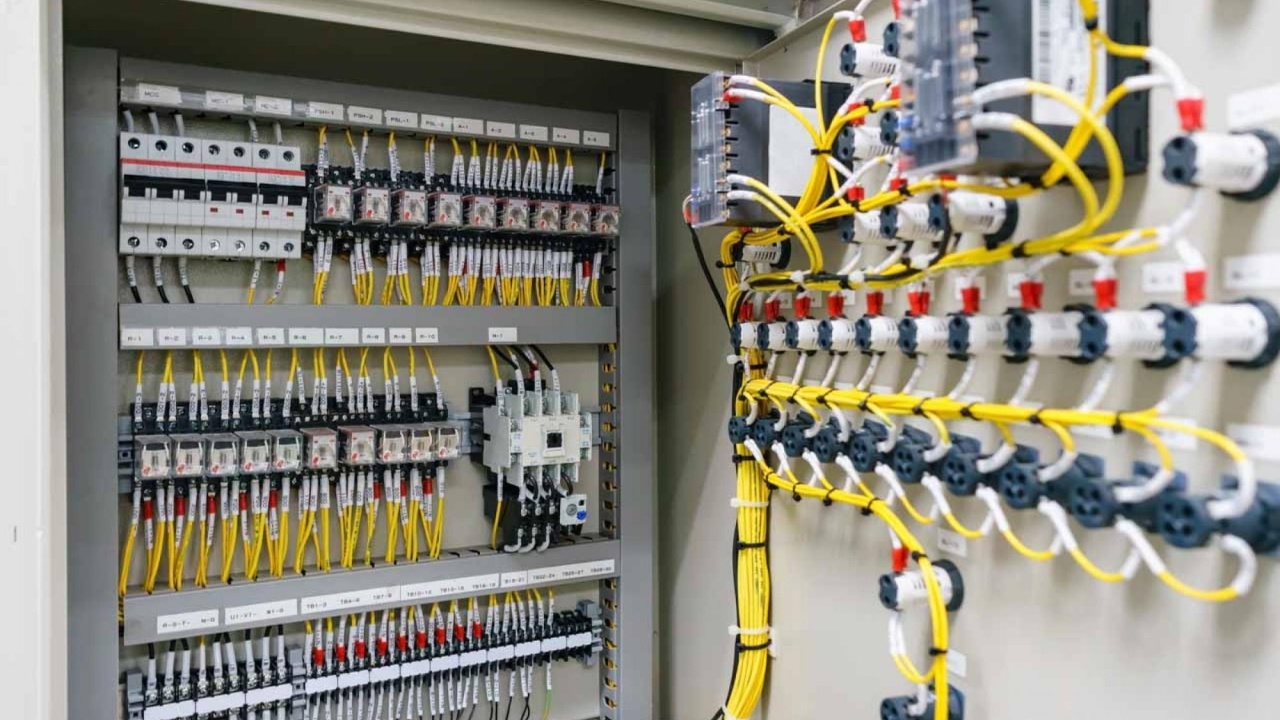As an electrical engineer, manufacturer, industry manager or factory distributor, you should automate your electrical projects. Now you can control your machines and equipment with the help of a programmable logic controller or PLC.
Let’s understand what PLC in electrical means and how it works. You will also learn programmable logic controller types and benefits in our daily life.
What is PLC in Electrical?

A programmable logic controller (PLC) is a special industrial computer with several parts. Actually it receives programmed data from your input and then transfers working instructions to machinery with its output. So basically, a PLC can automate your equipment’s functions with the help of internal programming.
For instance, you can use PLCs for controlling:
- Motors
- Switchgears
- Valves
- Robotic arms
- Sensors
- Safety shut-offs
- & conveyor belts etc.
That means if you are in a manufacturing industry, there is no need for multiple manual switches. You also get rid of complicated wires and hardware.
A programmable logic controller can easily work in rough and tough environments (very high and very low temperatures). Therefore, all electrochemical tasks of an industry are easily managed.
Main Components of PLC

- Processor/CPU Module: This part is also called the central processing unit. It receives your given program and changes into machine language which is a combination of binary code (0’s and 1’s).
- Input Assembly: This part is responsible for sending the input signals from processor to the controller.
- Output Assembly: Output assembly transfers the executed data from programmable logic controllers to the real world. Real world here means different applications of PLC around us.
- Communication Cards: Suppose you have multiple PLCs installed in your manufacturing unit. Then the whole system communicates with each other through these cards.
- Mounting/Rack: You can use the rack to join several parts of the PLC in a single place. That’s why it is also known as housing because it gives space to all PLC components.
- Power Supply: With the help of power supply, you provide required electric current to your programmable logic controller. General values of electric powers are 120V AC and 24V DC.
- Programming Unit or Interface: Every PLC has its own programming code and software. After taking help of the PLC programmer, you can program your PLC device in your personal laptop as well.
- Memory: Usually, memory is either present on a separate card or can also be the part of processor / CPU. It stores data and remembers the programs to automate your assigned functions.
- Input Output (IO) Cards: These cards will link your PLC unit to other instruments in your industry. They are of two types: analog and digital.
How Does a Programmable Logic Controller Work?

Since you have learned the above parts of PLC, you will easily understand the working of a PLC device. So how does it control machines and other factory processes?
- A programmable logic controller works by following your instructions. You can say the CPU is a brain of the PLC.
- It reads your program, understands the inputs and then finally decides what to do next.
- When you connect inputs such as switches and sensors to the PLC, the signals are sent to control elements like valves, lights & motors.
- They act as outputs. After this, your power supply generates DC voltage from AC voltage so the PLC can work properly.
Note:
You also use your laptop or computer to upload the PLC program. In the end, CPU processor creates the outputs i.e to turn on / off your motor and opening a valve.
Types of PLC

Following are 7 main types of programmable logic controllers which we will discuss today!
1. Modular PLC
In Modular PLC, you will see there is a base unit which has multiple communication ports and a processor. You can also add small-sized modules for increasing the functionality of modular systems. Therefore, as a user, you have more options to combine different I/O modules. This way your custom application needs are met.
2. Fixed Programmable Logic Controller
These PLCs are manufactured for highly specialized projects and you can’t modify them easily after installation. But they offer you money saving solutions if you want to do multiple repeating tasks with their help. Generally, people choose this programmable logic controller for those processes where parameters almost remain the same.
3. Mini PLCs
As the name says, they are tiny and low-cost logic controllers. Those users who are electrical engineers or industry managers utilize them for simple projects. However, the number of input and output points is less in Mini PLC compared to big programmable controllers.
The best part is you can install them very fast and without any hassle. Mostly they come with built-in properties such as pulse outputs and digital & analog outputs.
4. Safety PLC
At KDM Steel, we design safety programmable logic controller to ensure safe operations in your industrial automation. Your personnel, machinery and other equipment are protected according to global safety SOPs (for example IEC 61508).
Your safety PLC will have abilities of problem diagnosis, fault tolerance and high efficiency.
5. Micro PLC
Complexity level of micro PLCs is in between modular designs and mini PLC models. These devices are compact and you can handle more than one / two projects simultaneously. And you also don’t need additional hardware parts such as rack units and expansion cards.
Plus the micro programmable logic controllers come with ethernet network protocol. So, you can integrate them quickly into your factory or facility architecture.
6. Nano Programmable Logic Controller
Nano PLC is a latest edition computerized controller because of the following reasons.
- High speed processing and accuracy
- Ultra-small size
- Advanced microcontrollers
- Highly specific software tools to do their programming
You can use Nano PLCs in your complex applications which include pattern matching, axes movement, machine vision & object recognition.
7. PLCs With & Without Built-in Power Supply
We usually classify these programmable logic controllers based on their power supply.
Built-in Power Supply: A PLC with already installed power supply has a DC voltage of DC 48 or DC 24 inside its machine. You will not need an additional battery in this case.
Require External Source: Here the PLC does not have a built-in power source. That means you have to connect it with an external power such as a transformer / battery.
Functions of PLC (Programmable Logic Controller)

Diagnosis & Troubleshoots
Logic controllers offer you many diagnostic features and with their help, you can identify issues in your equipment. You will be able to see error messages and other detailed insights about the fault. Hence, the process of maintenance becomes much easier for you.
Alarm Management
Suppose you have set alarms in your factory to ring when an emergency condition arrives. This is where a PLC helps you. It constantly analyzes various circumstances and turns on the alarms when something exceeds the limits.
How does it do so? Because you already have programmed your PLCs to show response to this kind of situation.
Sequential Control
For instance you are manufacturing steel in your factory and this whole operation should follow a certain sequence step by step. Since you have stored this information in your logic controller’s memory, it will make sure everything is done in the right order.
Logic Control
PLCs are also good at the execution and control of many logic functions. They take input signals from switches and sensors. Then programmed logical rules are applied to determine a specific response. So a PLC can receive data from a sensor. Based on that info, it can decide when a motor’s speed should be adjusted.
Industrial Safety
You want to take care of your operators and equipment, right? Don’t worry because a logic controller helps your industrial control panels to follow international safety standards. Safety PLCs as we discussed earlier initiate stop functions in attacks or emergency conditions. Hence, the whole machinery is shut down to prevent accidents.
10 Advantages If You Use PLC in Electrical Projects

The benefits of PLC are as follows:
- Their scan time and implementation is very fast.
- They can also communicate with your other computers in the manufacturing plant.
- Their programming language is very easy to understand for everyone.
- You can purchase a PLC at a big range of prices because their basic models are very affordable. Moreover, startups and small business owners use them frequently due to this reason.
- Due to the computational ability of PLCs, you can calculate your project cost almost accurately.
- There is no specialized training you give to programmable logic controllers. You should only provide a program to their software and things are ready to go.
- They have a small physical size. So there is also no need to arrange a separate large area for their installation.
- PLCs are also energy efficient and don’t utilize much electricity.
- Since a logic controller works in real time, it can quickly respond to any change in sensor’s data. So a rapid action is guaranteed whenever there is an urgency or emergency.
- If we talk about the maintenance cost of a PLC, it’s very low. That means this is a good long term investment for you to reduce your manufacturing downtime.
Applications of Programmable Logic Controller

Many interesting applications of PLC are given below. You will be surprised to see how these logic controllers are expanding everywhere.
- Traffic signal lights
- Power generation & distribution systems
- Automatic working of electric parts
- Underground mines of coal
- Amusement park rides
- Glass, paper and cement manufacturing industries
- Fire detection system
- Roller coaster machine
- Automatic opening and closing of doors
- Smart healthcare and agriculture solutions
- Elevator and escalator
- Automated car washes
You will also observe PLC uses in automobile assembly lines, communication protocols and food & drinks packaging.
Final Thoughts

We hope in this guide, you have received all the relevant information about PLC in electrical systems. As you can see, programmable logic controllers are helpful in several industrial machineries and equipment.
Our team can customize the PLCs for your exact needs and also supply you PLC automation control panels and enclosures. Contact KDM today for free guidance and also get an instant quote.
FAQs
How You Can Choose Your PLC Model?
According to our experience, you should select a new PLC device after analyzing different factors. For example:
- Electrical voltage capacity of your facility
- Processing speed of CPU
- Tolerable temperature range if you want a PLC for very cold or hot manufacturing plant
- Considerable number of output and input ports to link with your system
- Programming language of PLC for your custom applications
- PLC scan time
- Physical size of a programmable logic controller to fit in your factory space
What is The Lifespan of a PLC?
If we talk about the average duration, it is from 5 to 20 years for PLC components. But the lifespan also depends on how regularly you do the maintenance of its parts.



